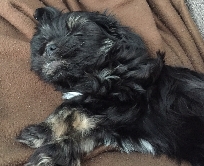
GALLERY 7 - BRINDLE
The general brindle pattern consists of a dark colour (black, silver or brown) overlaid in stripes, streaks or splotches onto a lighter base colour (cream, gold, red). Striping varies greatly ranging from broad sooty-edged stripes so thick you can barely see the light colour peeking through to a clear creamy colour with softly shadowed stripes. You may recognize this type of markings as being similar to a Boxer or Great Dane. New born brindle Havanese puppies will be noticeably mottled or striped. Brindling is best determined in puppies. As the coat grows out, stripes, steaks or splotches may be next to impossible to discern on adult dogs. Many Brindles sport a full or partial dark mask on the face. Dark ears and tail are common as is a dark dorsal stripe along the back. Brindle often has darker patterning appearing on dorsal areas and fainter patterning on ventral areas. See some Brindle colour changes in the Before & After galleries.
BRINDLE
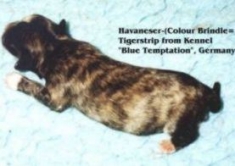
New born puppy from kennel Blue Temptation kennel in Germany. Dark splotches and streaks are easy to see on the gold base coat.
BLACK BRINDLE
Aranel from Kennel Kwanteen in Finland. The extent of brindling impacts adult appearance. The more brindling, the darker the coat looks.
RED BRINDLE PARTI

Gabby, bred by K&H kennel, is a richly coloured Red Brindle Particolour. Brindle can be the coloured portion of coats broken with white, like particolour and Irish Pied.
RED BRINDLE
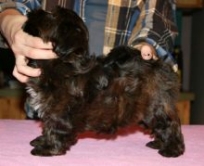
The brindling on this MistyTrails puppy is
extensive.You can barely see the rich red
base coat peeking through.
BRINDLE

Another brindle puppy from kennel Blue Temptation kennel in Germany. Pepper shows a very uniform scattering of black stripes.
BLACK/SILVER BRINDLE

Here is Pepper all grown up. As the coat
grows out, the black and silver streaking becomes indistinct and harder to identify.
RED BRINDLE IRISH PIED
Eye catching Niama is a deeply coloured
Red Brindle with Irish Pied markings.
Bred by K&H kennel and lovingly owned
by Robin Gillespie.
RED BRINDLE

This is Lea, a bright rich red with strong
black striping. She is one of the puppies
from the trio litter pictured above.
RED BRINDLE PUPPIES
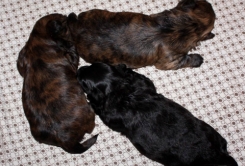
From VonDerWofspfote kennels in Germany; two red brindle puppies snuggled alongside their black sibling.
GOLD BRINDLE
Bred here at Mimosa, Meeko's undercoat coat is a combination of caramel gold with a light brindling of sooty stripes.
RED CHOCOLATE BRINDLE

Lego is a good example of a red brindle with liver pigment. His deep red base coat is extensively covered with chocolate brown stripes. See more of Lego on Gallery 17.
RED BRINDLE
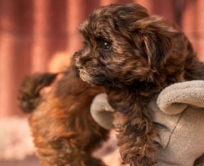
Queenie is another of the red brindle
puppies from the newborn photo above.
As we have already seen, Brindle is not necessarily all over the dog. It can appear as the coloured portion of the coat in a particolour or Irish Pied dog. Perhaps more unexpectedly, brindling may also appear in the light areas of patterned coats such as Black & Tans. Pictured here is my own Black & Tan Cricket, bred by Havana Canada. When she was a very young puppy, you can see how her tan points are brindled. Brindling is quite prominent through the tan areas of her chest and feet.
While Brindle is generally considered dominant over any "A" locus patterns (see the genetics section for more information) in some cases it appears to be incompletely dominant over the Black and Tan pattern. In this combination, the tan areas of the coat may be brindled.
Kate Jarvis's pretty little Josie is similar with extensive tan points and strong brindling. Josie goes one step further with the addition of white markings on her chin, chest and feet. She is Black and Tan Brindle with white markings.A close up photo shows the extensive brindling in the tan.